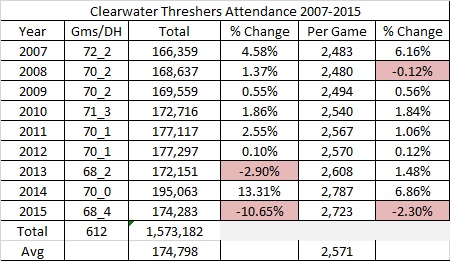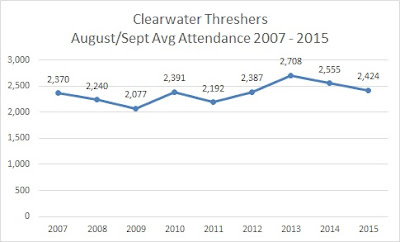Over the last few weeks, the Tampa Bay Business Journal, Tampa Bay Times, and DRaysBay published several articles that had bearing on the Tampa Bay baseball market.
The Tampa Bay Business Journal conducted a poll of their readers to determine the most influential people in Tampa Bay. Tampa Bay Lightning owner Jeff Vinik received the most votes: 44%. Rays owner Stu Sternberg received only 5% of the total votes.
I've stated this before. There is a huge difference in public perception between Jeff Vinik and any member of the Rays front office. Vinik is everywhere and is heavily invested in the community. Sternberg does not live in Tampa Bay and is rarely seen.
On a positive note, the Tampa Bay Business Journal listed the Top 25 Largest Job Announcements in Tampa Bay in 2015. Leading the way was Amazon.com, and their huge warehouse complex south of Tampa in the Ruskin-Bradenton area, which is hiring 2,000 workers in the area. The Amazon warehouse is 36.4 miles from Tropicana Field but is closest to the Bradenton Marauders home at McKechnie Field (24.7 miles).
While jobs are always a good thing, the Tampa Bay Business Journal also reports that the Tampa Bay area is 15th in the nation in income inequality. So people are getting paid, but there is a wide difference between the top earners and the bottom earners. That is not surprising in a region where our major industries are:
When tourism makes the list, you know there is going to be a gap in high and low earners. With a small market for professional sports, an area with high income inequality means only the high earners can afford luxury items such as season tickets, or even multiple trips to the ballpark.
Affording tickets is one problem, getting to the ballpark is another. The Tampa Bay Times had two interesting articles discussing transit in the Tampa Bay area. On Tuesday, January 19th, the Times wrote that the Tampa Bay Express expansion project was rated among the US's worst highway projects. It's not good when even "FDOT has acknowledged that adding the express lanes won't solve congestion problems", but still they are pushing for the project.
As we have talked about before, transit is a huge reason why people are not traveling to the far reaches of St Petersburg for Rays games.
Of course, there is slow movement in the Rays hunt for a new stadium. We can definitely expect several locations for a new ballpark to emerge over the next year. The fine folks over at DRaysBay looks at one possible location: the ConAgra plant in downtown Tampa. According to Daniel Russell, despite it's ideal downtown locale, we need to cross that location off the list.
One location that is still being considered is the Tampa Park apartments, but according to Field of Schemes, it might not look good for Mayor Buckhorn if he decides to relocated low income people from that area of the city.
The Tampa Bay Business Journal conducted a poll of their readers to determine the most influential people in Tampa Bay. Tampa Bay Lightning owner Jeff Vinik received the most votes: 44%. Rays owner Stu Sternberg received only 5% of the total votes.
I've stated this before. There is a huge difference in public perception between Jeff Vinik and any member of the Rays front office. Vinik is everywhere and is heavily invested in the community. Sternberg does not live in Tampa Bay and is rarely seen.
On a positive note, the Tampa Bay Business Journal listed the Top 25 Largest Job Announcements in Tampa Bay in 2015. Leading the way was Amazon.com, and their huge warehouse complex south of Tampa in the Ruskin-Bradenton area, which is hiring 2,000 workers in the area. The Amazon warehouse is 36.4 miles from Tropicana Field but is closest to the Bradenton Marauders home at McKechnie Field (24.7 miles).
While jobs are always a good thing, the Tampa Bay Business Journal also reports that the Tampa Bay area is 15th in the nation in income inequality. So people are getting paid, but there is a wide difference between the top earners and the bottom earners. That is not surprising in a region where our major industries are:
- Avionics, Defense and Marine Electronics
- Business and Information Services
- Financial Services
- Manufacturing (Microelectronics, Medical Devices)
- Marine Sciences
- Port/Maritime
- Tourism
When tourism makes the list, you know there is going to be a gap in high and low earners. With a small market for professional sports, an area with high income inequality means only the high earners can afford luxury items such as season tickets, or even multiple trips to the ballpark.
Affording tickets is one problem, getting to the ballpark is another. The Tampa Bay Times had two interesting articles discussing transit in the Tampa Bay area. On Tuesday, January 19th, the Times wrote that the Tampa Bay Express expansion project was rated among the US's worst highway projects. It's not good when even "FDOT has acknowledged that adding the express lanes won't solve congestion problems", but still they are pushing for the project.
As we have talked about before, transit is a huge reason why people are not traveling to the far reaches of St Petersburg for Rays games.
Of course, there is slow movement in the Rays hunt for a new stadium. We can definitely expect several locations for a new ballpark to emerge over the next year. The fine folks over at DRaysBay looks at one possible location: the ConAgra plant in downtown Tampa. According to Daniel Russell, despite it's ideal downtown locale, we need to cross that location off the list.
One location that is still being considered is the Tampa Park apartments, but according to Field of Schemes, it might not look good for Mayor Buckhorn if he decides to relocated low income people from that area of the city.






















